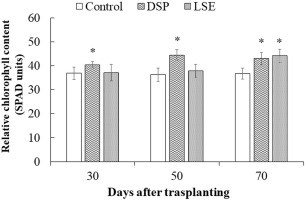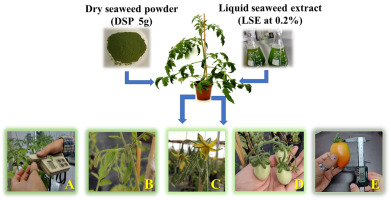. Introduction
Tomato (Solanum lycopersicum L.) is one of the most popular horticultural crops in the world in terms of human consumption and other industrial uses (O. Ali et al., 2019). Furthermore, tomato production represents an important source of income for rural and peri-urban producers in several countries worldwide (Suchithra et al., 2022). In 2022, Mexico was the eighth largest producer of tomatoes in the world, producing nearly 3.46 million tons (Government of Mexico, 2024; https://www.gob.mx). As with other crops, the productive fitness of tomato is largely dependent on the plant’s ability to form and mature flowers and fruits (Hussain et al., 2021). Therefore, enhancing reproductive development through the use of natural products is a sustainable strategy to increase crop yield and quality and minimize dependence on synthetic chemical inputs that impact the environment (Ma et al., 2022).
Seaweeds represent a diverse and abundant marine resource along the world’s coastlines, with great potential as a source of biofertilizers and biostimulants for modern horticulture (Di Stasio et al., 2017). Several studies have demonstrated the beneficial effects of seaweed-derived products on the vegetative growth and yield parameters of tomato plants (O. Ali et al., 2019; Hussain et al., 2021). However, there is limited information on the phenotypic response of plants treated with these products to reproductive development traits, and most of these studies focus on the evaluation of the biostimulant properties of brown seaweed-derived formulations. In particular, seaweed extracts have been demonstrated to stimulate early flowering, increased flower formation, and improved fruit set in a variety of crop plants, including bean, pepper, and tomato (N. Ali et al., 2016; O. Ali et al., 2019; Dookie et al., 2020; El-Yazied et al., 2012). These positive effects during the reproductive development phase inevitably led to an improvement in crop yields. More recently, Hussain et al. (2021) observed an increase in the number of flowers and fruits in response to the application of a commercial brown seaweed extract, and Dookie et al. (2020) reported increased expression levels of flowering genes, following the application of alkaline extracts derived from Ascophyllum nodosum or Sargassum sp.
In turn, few studies have evaluated the agricultural potential of green algal species (Ma et al., 2022). In a previous study, we reported that treatment with the green alga Ulva ohnoi (i.e., dry seaweed powder and liquid seaweed extract) improved the vegetative growth attributes of tomato plants (Espinosa-Antón et al., 2023). Therefore, we hypothesize that the application of U. ohnoi will accelerate the initiation of flowering and enhance flower and fruit formation by improving the nutritional status and growth characteristics during the vegetative phase. The objective of this study was to evaluate the effects of drench application of the dry seaweed powder and a liquid seaweed extract of U. ohnoi on the reproductive development of tomato.
. Material and methods
Obtention of dry seaweed powder and preparation of seaweed liquid extracts
Ulva ohnoi biomass was obtained from the company Productos Marinos de las Californias S. DE R.L. DE C.V., Ensenada, Mexico. A liquid extract at 0.2% was obtained as in Espinosa-Antón et al. (2023). The application of 5 g of the dry seaweed powder every 15 days and 250 mL of the liquid seaweed extract at 0.2% every 7 days was previously established by Espinosa-Antón et al. (2023).
Greenhouse experiment
The experiments were conducted using certified Solanum lycopersicum L. cv. “Rio Fuego” seeds (Kristen Seed, San Diego, CA, USA).
The tomato plants were transplanted into individual 5 L pots with vermiculite, peat moss, and soil in a ratio of 1:1:1 (v/v) and grown in greenhouse conditions with 16 h light regime at 30 °C and 8 h dark regime at 16 °C, and relative humidity 70 to 85% for 75 days after transplanting (DAT). The plants were watered daily with 250 mL of water and fertilized every two weeks with 150 mL of N–P–K solution (20:20:20) until the end of the experiment. The plants were arranged in a completely randomized design, with each treatment row (six plants) replicated two times (n = 12). Treatments: (1) plants treated with 5 g of dry seaweed powder (DSP) every 15 days; (2) plants treated with 250 mL of liquid seaweed extract at 0.2% (LSE) every 7 days; and (3) control plants (without seaweed). Both DSP and LSE treatments were applied directly to the substrate surface with the drench method one week after transplanting and every 7 or 15 days thereafter until the end of the experiment.
Data collection from the reproductive development stage of the tomato crop
Data were collected during the reproductive development stage of the tomato crop (30 to 70; DAT), corresponding to the flowering and early fruiting periods. All the plants were monitored each day to determine when the first flowers emerged and opened. The reproductive parameters evaluated on the treated plants included the number of flower clusters, buds, flowers, and fruits (Figure 1).
Chemical analysis of tomato plants
Chlorophyll content in leaves at 30, 50, and 70 DAT was measured with a non-intrusive method using a SPAD 502 Plus portable chlorophyll meter (Minolta; Spectrum Technologies Inc., Aurora, IL, USA) and expressed as equivalent to SPAD units. On the other hand, at 50 DAT, leaf samples were collected from the same 12 plants from each treatment to determine the nutrient composition. Nitrogen, potassium, calcium, magnesium, sulfur, and iron were then determined using a 240FS AA atomic absorption spectrometer (PerkinElmer, Santa Clara, CA, USA), while phosphorus was determined by colorimetry (Espinosa-Antón et al., 2023). The parameters of tomato fruits, such as total soluble solids and pH, were measured using a portable refractometer and a HI 2211 pH meter (Hanna Instruments). All mineral measurements were performed with three replicates.
Data were analyzed using one-way ANOVA and Dunnett’s multiple comparison of means (p < 0.05).
. Results
Reproductive development stage of the tomato crop
In this study, at 30 DAT, flower bud formation was observed in the three experimental groups, indicating the beginning of the reproductive stage. However, the first opened flowers were observed at 35 DAT in the DSP-treated plants, indicating a reduction of five days in the start of the flowering process compared to the control plants. Similarly, the treatment with DSP resulted in an increase in the number of flower clusters (55%), buds (103%), and flowers (61%) at 50 DAT and the number of fruits per plant (45%) at 70 DAT compared to the control plants (Table 1). In contrast, the LSE-treated plants did not show significant differences in the reproductive parameters compared to the control plants.
Table 1
Effect of dry seaweed powder (DSP) and liquid seaweed extract (LSE) of U. ohnoi on the reproductive development of tomato plants.
Chemical analysis of tomato plants
The results obtained from the chemical analysis of plants from the DSP treatment showed a significant (p < 0.05) increase in the foliar content of N (45%), K (19%), P (20%), Ca (8%), Mg (31%), S (24%), and Fe (17%), while the SLE treatment increased the content of P (25%) and Fe (25%) compared to the control plants (Table 2). In the same way, the DSP treatment enhanced the dry matter, total soluble solid, and pH in the tomato fruits (Table 3).
Table 2
Minerals content in foliar tissue of tomato plants treated with dry seaweed powder (DSP) or liquid seaweed extract (LSE) of Ulva ohnoi.
Table 3
Dry matter (DM), total soluble solid (° Brix) and pH in tomato fruits treated with dry seaweed powder (DSP) or liquid seaweed extract (LSE) of Ulva ohnoi.
| DM | ° Brix | pH | |
|---|---|---|---|
| Control | 5.88 ± 0.54a | 3.98 ± 0.67a | 4.26 ± 0.78b |
| DSP | 5.94 ± 0.78a | 4.08 ± 0.68b | 4.33 ± 0.99c |
| LSE | 6.07 ± 0.74a | 4.15 ± 0.48b | 4.19 ± 0.81a |
Likewise, the DSP treatment significantly increased the chlorophyll content at 30 DAT (3.5 units), 50 DAT (8.1 units), and 70 DAT (6.2 units), while the SLE treatment had a similar effect at 70 DAT (6.2 units) compared to the control plants (Figure 2).
Figure 2
Relative chlorophyll content in the leaves of tomato plants treated with dry seaweed powder (DSP) and liquid seaweed extract (LSE) of Ulva ohnoi. The vertical bars represent mean ± standard error (n = 12 plants). The asterisk (*) in the bars indicates significant differences in comparison to the control group based on Dunnett’s test (p < 0.05).

. Discussion
Our study shows that the treatment with the green algae Ulva ohnoi in its natural form (dry powder) improved the reproductive development parameters of the tomato plants. Similarly, greenhouse tomato plants exhibited an increase in the number of flowers and fruits after soil application of the dry biomass of the green algae Acutodesmus dimorphus and Chlorella vulgaris and the brown algae Sargassum johnstonii (Garcia-Gonzalez & Sommerfeld, 2016; Suchithra et al., 2022). More broadly, other studies have also shown that application of seaweed extracts induces early flowering and increased fruit set in tomato and pepper plants (N. Ali et al., 2016; O. Ali et al., 2019; Hussain et al., 2021; Suchithra et al., 2022).
The observed results may be partially related to the biostimulant and biofertilizer properties of the algal products/extracts. This is due to the presence of bioactive compounds in algae, including various types of polysaccharides, amino acids, phenolic compounds, and plant growth regulators, which stimulate the absorption and assimilation of nutrients essential for crop growth and development (Di Stasio et al., 2017). In particular, the reproductive phase represents a critical developmental transition point during which plants reallocate their metabolism and require specific amounts of certain nutrients (Hussain et al., 2021). For the flowering stage, the tomato requires large amounts of P (responsible for the number of flowers and buds that form) and K (promotes flower initiation), while during the fruiting stage, the most needed elements are K (stimulates flower maturation and fruit formation) and Ca (promotes adequate fruit growth) (Bodale et al., 2021). The aforementioned information is in accordance with the results of our study on the nutritional status of U. ohnoi-treated plants during the reproductive phase, as expressed through foliar mineral and chlorophyll content (Table 2, Figure 2).
Another possible explanation for our findings is related to our previous research, which demonstrated the promotion of microbial growth in the soil of tomato plants following the application of DSP and SLE of U. ohnoi (Espinosa-Antón et al., 2023). In this regard, Hussain et al. (2021) suggested that the observed increase in the number of flower clusters, flowers, and fruits in tomato plants grown in soil treated with seaweed extracts was due to an increase in beneficial bacterial families in the rhizosphere at flower initiation. On the other hand, it is possible that the bioactive compounds present in U. ohnoi induced the overexpression of key genes in reproductive morphogenesis (Dookie et al., 2020).
This study provides the first evidence of the biostimulant effect of U. ohnoi powder on tomato reproductive development, justifying its use to improve yield and quality in greenhouse horticulture crops.



